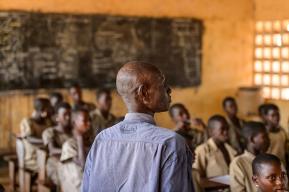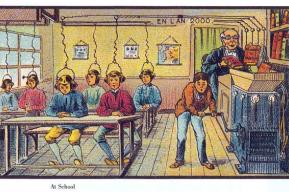Idea
Time to go out and play

By Hayley Christian
Children occupying public places is a common theme in early 20th century street photography: they carry loads, wear backpacks to school, run around, float paper boats in Parisian gutters, or play in water sprayed from fire hydrants in New York – without an adult in sight. Nowadays, it’s hard to get such shots. The sight of young children playing, walking or cycling in public places without adult supervision has become rare.
The world has indeed witnessed a significant decline over recent generations in outdoor play and children’s independent mobility. The drop in outdoor play time is our first clue to declining physical activity levels – the two are inextricably entwined, with the amount of time a child spends outdoors being the biggest determinant of how much physical activity they get.
The World Health Organization recommends children from one to five years old spend at least three hours per day in a variety of physical activities, while children aged between five and seventeen should engage in at least one hour of moderate to vigorous intensity physical activity daily. However, based on a recent review covering 29 countries, children aged from three to twelve years receive 60–165 minutes of outdoor play each day.
The Active Kids Global Alliance reports similar findings. Their Global Matrix 4.0 from October 2022 provides a comprehensive assessment of child and youth physical activity across 57 countries and six continents. The conclusion is that children's physical activity levels are clearly insufficient around the world.
Countless benefits of outdoor play
The situation is alarming when we consider how important outdoor activities are for a child’s health and development. The concept of play is so critical for a child that the right to play is preserved in the United Nations Convention of the Rights of the Child. What makes outdoor play so unique is that it involves activity that is freely chosen, spontaneous, self-directed and enjoyable. It supports children’s social-emotional, cognitive and physical development.
In addition, it’s good for your health. Children who meet physical activity guidelines have a reduced risk of chronic diseases such as obesity, cardiovascular disease and type 2 diabetes. They also have better mental health, improved cognitive and executive function, and greater overall well-being.
Good habits are more likely to become permanent if they are started early. Similarly, sedentary behaviours, as well as overweight and obesity, tend to track across childhood into adulthood. Daily outdoor play helps children develop the essential fundamental movement skills, such as running, hopping, skipping, and jumping, required to help them become confident movers throughout life.
Also, playing outdoors gives children the opportunity to interact with family members, peers and other community members. It helps them develop skills such as social competence, risk management and creativity, as well as independence and self-determination – essential life skills – and encourages them to navigate and learn about their environment.
Research shows children have improved attention and concentrate better in the classroom following periods of outdoor play. Active outdoor play increases blood flow to the brain which can assist with tasks involving executive functions.
Research shows children have improved attention and concentrate better in the classroom following periods of outdoor play
When play happens “in nature” it provides additional benefits. It facilitates greater exploration, imagination and interaction with people, plants and animals, and helps children to develop environmentally friendly behaviours.
“Risky play”, which can involve speed, tools, or play near fire or water, also has a role to play in a child’s development. This kind of play teaches children how to master risk and evolve with it. However, society has increasingly restricted risky play opportunities through social norms that insist on constant supervision and consider parents to be neglectful if they don't conform. Parents themselves have incorporated these social norms, driven by the perception of the “outside” as a potentially dangerous place.
Closer to home, parents act as gatekeepers who either provide opportunities or barriers to children’s outdoor play. Many parents are concerned about traffic hazards or kidnappings - despite data from the United Nations Office on Drugs and Crime showing that child abduction rates have remained stable. Social media has fuelled these concerns, creating risk-averse societies. Research has confirmed an increase over time in overprotective behavior and hyper-parenting styles, such as so-called “helicopter parenting”.
Rapid urbanization
Modern society presents another big barrier. We schedule so much more into our day – leaving little or no time for unstructured outdoor time with children. As any parent knows, the influence of screen time constantly competes with children’s desire to be outdoors.
Another major long-term limiting factor is rapid urbanization. More than one billion children globally live in urban environments, and 70 per cent of the world’s population will live in cities by 2050. This phenomenon can lead to increased traffic, air pollution and urban heat island effects while reducing natural green spaces and biodiversity – all of which negatively impact children’s opportunities to play outdoors.
Hyper-parenting trend can disadvantage children by depriving them of essential activities for their development
Enabling children’s right to daily outdoor play
Children will play outdoors more if their parents and carers are positive about physical activity and about being outdoors in nature. Therefore, one of the most practical steps families can take is to make sure there is unstructured time for family play every day, especially on weekends.
Providing opportunities for children to play outdoors is easier when the social, physical and policy environment supports their right to play. We need to wrap children and families in supportive environments that make outdoor play an easy, safe and enjoyable experience. Building neighbourhood social capital and a sense of community can help alleviate some of parents’ perceived concerns about how safe their area is when it comes to outdoor play. One way to push back against the hyper-parenting trend is to highlight that it can disadvantage children by depriving them of activities that are essential for their development.
Providing opportunities for children to play outdoors is easier when the social, physical and policy environment supports their right to play
Children need access to safe, local green space and parks with age-appropriate, universally designed, child-friendly features. Other key ingredients for outdoor play-friendly environments include low traffic volumes and speeds, traffic-calming strategies such as school crossings, and pedestrian infrastructure (connected footpaths and cycle lanes). For younger children, the home yard and safe, accessible spaces close to the home – such as the front of the house, adjoining footpaths and verges – are also key outdoor play spaces.
Ultimately there is no single solution when it comes to reversing declining levels of outdoor play. It’s an issue we need to tackle at every level – parent and child, neighbourhood, the physical and policy environment, all the way up to societal level.
The most powerful voice in all of this is that of children – especially those experiencing disadvantage. Every child has the right to play outside every day, and we must protect that right. The time to play is now. It is our global responsibility to fiercely protect the right of every child to play outdoors each and every day – now and into the future.
Hayley Christian
Associate Professor at the Telethon Kids Institute and School of Population and Global Health, University of Western Australia, she leads the PLAYCE research programme which focuses on improving children’s physical activity, health and well-being.











